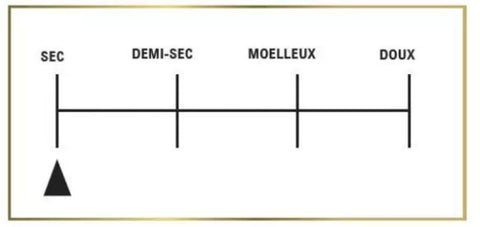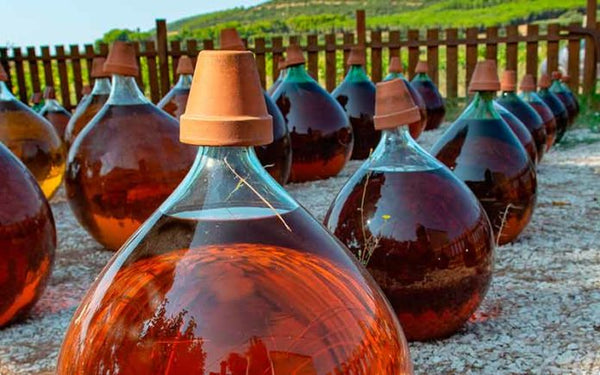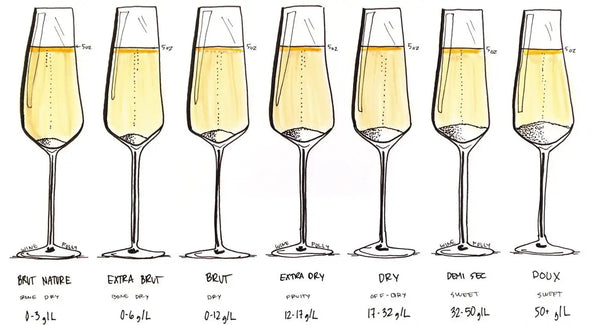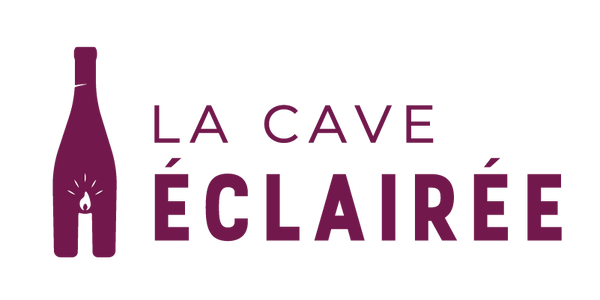But what exactly do they mean? ? Do you know where the sugar in wines comes from? ? How do the sweet wines are they elaborated? Explanations.
A question of vocabulary
First, let's talk about the dry wines . Please note that this adjective is not used here to characterize the style of a wine but simply provides information on the residual sugar level (or final) contained in a bottle. In this case, a dry wine cannot contain maximum 4g/L of sugar (i.e. 3g for a 75cl bottle). Suffice to say that at this level, it is generally imperceptible to the taster. A wine " dry » is therefore a wine with almost no residual sugar.
Then come the following categories: :
➡️ Semi-dry : between 4g and 12g/L
➡️ Soft : between 12g and 45g/L
➡️ Sweet or sweet : more than 45g/L
A sweet wine is therefore sweeter than a moelleux wine, which is itself sweeter than a semi-dry wine.
 Sweetness scale of still wines
Sweetness scale of still wines
Alcoholic fermentation
Now that these terms are clear, let's look at how our sugar ends up in the final bottle.
As you know, grapes have sugars in their natural state (like all fruits). Well, except for the very specific case of chaptalization , The sugars in wines simply come from...grapes ! Indeed, once the harvest is finished, the winemaker carries out what is called the alcoholic fermentation . This is when the sugar present in the grapes is naturally converted into alcohol by microorganisms called yeasts . This is the moment when grape juice becomes wine.
The winemaker can then decide either to let the fermentation run its course (it stops when the yeasts no longer have any sugar to eat or when the alcohol level reaches around 15% because they no longer have any sugar to eat). can survive beyond this), or to stop it by its own action so that all the sugar present is not converted into alcohol.

Alcoholic fermentation in progress
For example, in order to achieve Sauternes from Château Haut-Bergeron , the alcoholic fermentation is completed. However, as the grapes are harvested when overripe and have a lot of sugars in their natural state, these are not all converted into alcohol and a large part is therefore still present in the bottle for our greatest pleasure.
On the contrary, naturally sweet wines (VDN for short) like those of Mas Amiel in Maury, the Porto such delicious Tawny 10 years from Quinta da Ervamoira , or even the Muscat of Rivesaltes like that of the Schist Domain in Roussillon had their alcoholic fermentation voluntarily stopped by the addition of a wine brandy bringing the wine above 15% alcohol, thereby killing all yeast and leaving so sugar remaining intact.
This addition of alcohol can also take place before fermentation. In this case, all the sugars present in the grapes are preserved. This is the method used for " liqueur wines » like the Macvin of Jura or Pineau des Charentes. To simplify, these are a mixture of grape juice and alcohol.
Finally, other methods such as the cooling wine and its filtration can be used to eliminate yeasts. This is for example the case for making the delicious Vouvray semi-dry Or soft of the domain François and Julien Pinon .

Aging in demijohn of a Natural Sweet Wine
The special case of sparkling wines
For the effervescent (cremants, proseccos , champagnes etc.), another hierarchy exists to qualify the levels of residual sugars :
➡️ Brut nature : between 0 and 3g/L
➡️ Extra raw : between 0 and 6g/L
➡️ Raw : between 0 and 12g/L
➡️ Extra dry : between 12 and 17g/L
➡️ Dry : between 17g and 32g/L.
➡️ Semi-dry : between 32g and 50g/L. The same term is used for wines without bubbles, so be careful not to confuse them!
➡️ Soft : more than 50g/L. Same remark as previously.
Besides this semantic difference, The sugar found in the final bottle of sparkling wine does not come from the grapes ! Indeed, at the time of the final bottling of a crémant or champagne, the winemaker will add to the wine a dosage (or expedition) liqueur . It is this liqueur composed of wine and cane sugar which, depending on its sugar content, will give our bubbles their designation Extra Brut, Brut, Demi-sec etc.
Some areas like Widow Fourny & Sons decides to respect as much as possible " the grape universe » and choose for their champagnes a dosage liqueur composed of grape sugar ! This remains a rarity, however.

Sweetness scale sparkling wines
Conclusion
As you will have understood, if the residual sugar present in sparkling wines comes from an external addition and is very generally cane sugar, for non-sparkling wines, the sugar does indeed come (except for chaptalization) from the grapes.
Furthermore, the production of semi-dry, sweet or sweet still wines can be done in different ways. Either the wine comes from overripe grapes containing a high sugar content and its fermentation stops naturally when the alcohol content becomes too high, i.e. winemaker decides to voluntarily stop this fermentation by its own means (cold and filtration, addition of strong alcohol, etc.).
These choices depend on many factors such as the AOC rules, the grape variety, the climate or even the desire of the winemaker.
As a conclusion, I would advise you to be attentive above all to the concept of balance wine tasted rather than raw figure expressing the sugar in it (except for diabetics)😉 ). Indeed, a high sweetness can be perfectly balanced by a nice acidity as well as a gourmet aroma while a wine in fact less sweet can seem heavy to you. even sickening if it is not harmoniously constructed.
See you soon at The Illuminated Cellar !




















1 comment
Merci pour ces informations !